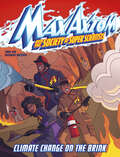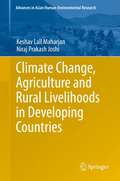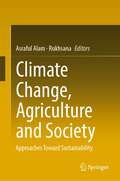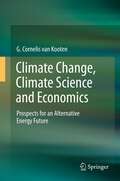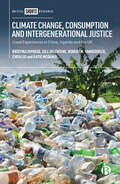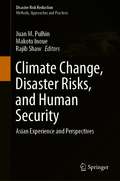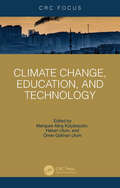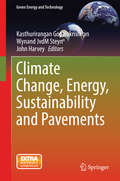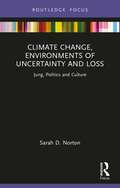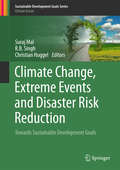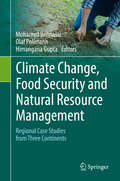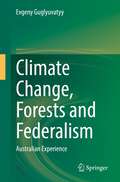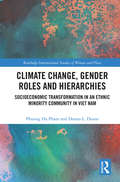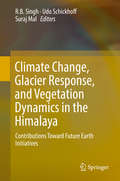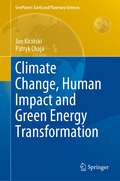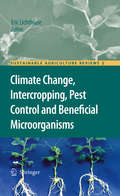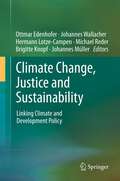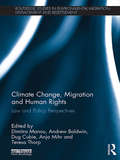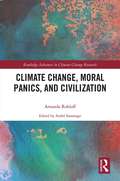- Table View
- List View
Climate Change on the Brink: A Max Axiom Super Scientist Adventure (Max Axiom and the Society of Super Scientists)
by Carol KimEarth’s climate is changing. Heat waves and droughts are more common and more severe. Powerful hurricanes cause widespread damage. And polar regions are warming fast, causing even more problems around the world. Why is this happening? In this nonfiction graphic novel, Max Axiom and the Society of Super Scientists go on an exciting, fact-filled adventure that will help young readers learn about the causes and effects of climate change and learn ways that they can make a difference.
Climate Change, Adaptation and Gender: Policy, Practice and Methodological Underpinnings (CABI Climate Change Series #17)
by Dr Mamta Mehar Professor Narayan PrasadThis book offers a wide, in-depth study of the gender-climate change-agriculture nexus. The crux of understanding these connections comprises gender equality and tools to measure gender discrimination, the evolution of the concept of gender inclusiveness and its concerns; and the need to address the same by formulating gender-inclusive policymaking. Despite the fact that more than 50 years have elapsed since gender concerns were included in explorations of this nexus, there is still ambiguity around the foundations, connections, and approaches for planning gender-inclusive climate policies. This book aims to clear that ambiguity by: · Being the first to explore exclusively this issue in detail. · Revealing how and why consideration of gender is so important for understanding how climate change impacts rural communities and agricultural systems globally. · Exploring every dimension of climate change (including belief systems and perceptions, knowledge, experience, coping strategies, adaptation, and mitigation strategies) and linking it to gender. It includes new theoretical and methodological approaches that go far beyond the household as the unit of analysis (using various approaches, including intersectional analysis). The book not only throws light on major themes of research, but also covers different methodologies ranging from review methods to mathematical models, conceptual frameworks and empirical analysis. It will be of wide interest to students, scholars, and researchers in gender studies, agriculture, climate change and rural development research, and also to practitioners, extension workers, and planners designing new climate-resilient practices.
Climate Change, Agriculture and Rural Livelihoods in Developing Countries (Advances in Asian Human-Environmental Research)
by Keshav Lall Maharjan Niraj Prakash JoshiThis book is about climate change and its relation to agriculture and rural livelihoods. It starts by providing a basic understanding of climate change science followed by the relation of climate change to agriculture, the impact of which is discussed based on the particular impact of climate change on plant and animal physiology. The book further discusses the inclusion of the agriculture sector in various international climate change negotiations. It also reviews the cost and opportunities for agricultural projects through international climate change regimes, specifically the Clean Development Mechanism under the Kyoto Protocol. With this background, the book finally proceeds to an explanation of the methodologies used to assess the impact of climate change on agriculture and empirically discusses its impact on agriculture and rural livelihoods in Nepal.
Climate Change, Agriculture and Society: Approaches Toward Sustainability
by Rukhsana Asraful AlamThis book discusses emerging contexts of global warming and climate change, agricultural vulnerability and adaptation from local to global scale. Climate change, resilience in relation to agriculture and livelihoods and multi-dimensionality of various approaches are clearly taken into account by providing studies and perspectives on various methods and scales based on natural science to social science frameworks. This edited work contains chapters that are interdisciplinary, covering climate change, agriculture vulnerability, disaster impact, productivity efficiency, food security, livelihood resilience, land degradation, sustainability, in terms of plan and perform for transformation, sustainability and adaptation, including philosophy, change and economics, as well as the natural sciences. This book addresses the sustainable development goals to reduce the adverse impacts on agricultural productivity brought on by climate change and its adaptation and disaster risk reduction in developing and developed nations. Some of the assessed challenges include soil erosion, land use conversion, natural resource mismanagement, crop productivity decline and economic stagnation. This book covers important issues in the production and consumption of food in the past and present periods, agriculture, livelihood, and climate change, disaster risk management and society. All of these are under the threat of ongoing climate change and significant challenges to livelihood sustainability. The book is arranged into five broad sections: each part will cover a set of chapters dealing with a particular issue of the climate change, agriculture and society: approach toward sustainability. This book aims to attract attention of students, researchers, academician, policymakers and other inquisitive readers interested in different aspects of climate change, agriculture, livelihood and sustainability, particularly at local to global context.
Climate Change, Capitalism, and Corporations
by Christopher WrightClimate change is one of the greatest threats facing humanity, a definitive manifestation of the well-worn links between progress and devastation. This book explores the complex relationship that the corporate world has with climate change and examines the central role of corporations in shaping political and social responses to the climate crisis. The principal message of the book is that despite the need for dramatic economic and political change, corporate capitalism continues to rely on the maintenance of 'business as usual'. The authors explore the different processes through which corporations engage with climate change. Key discussion points include climate change as business risk, corporate climate politics, the role of justification and compromise, and managerial identity and emotional reactions to climate change. Written for researchers and graduate students, this book moves beyond descriptive and normative approaches to provide a sociologically and critically informed theory of corporate responses to climate change.
Climate Change, Climate Science and Economics: Prospects for an Alternative Energy Future
by G. Cornelis van KootenThis volume enables readers to understand the complexity associated with climate change policy and the science behind it. For example, the author describes the criticism and defense of the widely known "hockey stick" temperature graph derived from combining instrumental data and proxy temperature indications using tree ring, ice core and other paleoclimatic data. Readers will also learn that global warming cannot easily be avoided by reducing CO2 and other greenhouse gas emissions in rich countries. Not only is emissions reduction extremely difficult in rich countries, but demands such as the UN mandate to improve the lives of the poorest global citizens cannot be satisfied without significantly increasing global energy use, and CO2 emissions. Therefore, the author asserts that climate engineering and adaptation are preferable to mitigation, particularly since the science is less than adequate for making firm statements about the Earth's future climate. Readers will also learn that global warming cannot easily be avoided by reducing CO2 and other greenhouse gas emissions in rich countries. Not only is emissions reduction extremely difficult in rich countries, but demands such as the UN mandate to improve the lives of the poorest global citizens cannot be satisfied without significantly increasing global energy use, and CO2 emissions. Therefore, the author asserts that climate engineering and adaptation are preferable to mitigation, particularly since the science is less than adequate for making firm statements about the Earth's future climate.
Climate Change, Consumption and Intergenerational Justice: Lived Experiences in China, Uganda and the UK
by Gill Valentine Kristina DiproseThe United Nations 2030 Agenda for Sustainable Development makes climate change and responsible consumption key priorities for both industrialized and emerging economies. Moving beyond the Global North, this book uses innovative cross-national and cross-generational research with urban residents in China and Uganda, as well as the UK, to illuminate international debates about building sustainable societies and to examine how different cultures think about past, present and future responsibility for climate change. <p><p> The authors explore to what extent different nations see climate change as a domestic issue, whilst looking at local explanatory and blame narratives to consider profound questions of justice between those nations that are more and less responsible for, and vulnerable to, climate change.
Climate Change, Disaster Risk, and the Urban Poor
by Judy L. BakerPoor people living in slums are at particularly high risk from the impacts of climate change and natural hazards. They live on the most vulnerable lands within cities, typically areas that are deemed undesirable by others and are thus affordable. Residents are exposed to the impacts of landslides, sea-level rise, flooding, and other hazards. Exposure to risk is exacerbated by overcrowded living conditions, lack of adequate infrastructure and services, unsafe housing, inadequate nutrition, and poor health. These conditions can turn a natural hazard or change in climate into a disaster, and result in the loss of basic services, damage or destruction to homes, loss of livelihoods, malnutrition, disease, disability, and loss of life. This study analyzes the key challenges facing the urban poor given the risks associated with climate change and disasters, particularly with regard to the delivery of basic services, and identifies strategies and financing opportunities for addressing these risks. Several key findings emerge from the study and provide guidance for addressing risk: * The urban poor are on the front line. The poor are particularly vulnerable to climate change and natural hazards due to where they live within cities, and the lack of reliable basic services. * City governments are the drivers for addressing risks. Local governments play a vital role in providing basic services which are critical to improving the resilience of the urban poor. * City officials build resilience by mainstreaming risk reduction into urban management. Climate change adaptation and disaster risk reduction can be best addressed and sustained over time through integration with existing urban planning and management practices. * Significant financial support is needed. Local governments need to leverage existing and new resources to meet the shortfalls in service delivery and basic infrastructure adaptation.
Climate Change, Disaster Risks, and Human Security: Asian Experience and Perspectives (Disaster Risk Reduction)
by Rajib Shaw Makoto Inoue Juan M. PulhinThis book explores how climate change and disaster risks threaten human security in Asia. Climate change and disaster risks have emerged as major human security challenges in the twenty-first century, and are an imminent “threat multiplier” with the potential to harm the vital core of human life and curtail people’s freedom and ability to live with dignity. Climate change and disaster risks undermine the security of individuals, communities, nations, and the world, considering the increasing trend in the frequency and magnitude of hydro-meteorological disasters and the projections on their future adverse impacts. Despite recent advances in the literature, there is still a major gap in understanding the relationship and linkages between climate change, disaster risks, and human security, particularly as gleaned from the Asian experience. Asia is the world’s most vulnerable region in terms of the quantity and magnitude of impacts from various forms of disaster. At the same time, it has developed a number of innovative responses to address those risks, offering a wealth of experience. Exploring and capitalizing on the Asian perspective, this book provides valuable resource material for students, academics, researchers, policymakers, and development practitioners working in these areas.
Climate Change, Disaster and Adaptations: Contextualising Human Responses to Ecological Change (Sustainable Development Goals Series)
by Azizur Rahman Siddiqui Avijit SahayThis volume examines how local communities respond and adapt to ecological changes and disasters resulting from climate change. The main aim of the book is to understand the range of human responses to ecological change and to contextualise the reasons for adopting any particular adaptive strategy by a community. Through the help of specific case studies presented as individual chapters, the book aims to find out whether adaptation due to environmental stress is an individual decision and, therefore, is an isolated phenomenon, or if resilience and adaptation are part of the same action paradigm of society as a whole in response to environmental change. Of particular interest are the case studies of climate change or disasters that have rendered the site unsuitable for the return of its community at present, and thus necessitated the relocation of such communities to new locations. The case studies in the book focus on regions in India, but cover different parts of the world as well, and address concepts of resilience, vulnerability, risk, adaptation, and mitigation. The book will be useful for students and researchers in the fields of geography, disaster management, environmental science, and anthropology.
Climate Change, Education, and Technology
by Ömer Gökhan Ulum Hakan Ulum Menşure Alkış KüçükaydınThe climate change crisis is the greatest challenge humanity has ever confronted. As human activities are the most significant cause for this crisis, the solution must come from within humanity. While global movements—NGOs, universities, municipal governments, etc.—are doing their part to combat the crisis, the role of education and technology cannot be emphasized enough. Education is necessary to enhance awareness, especially among the youth, generate solutions, and implement them. Technology contributes to this process by creating climate change-fighting solutions, accumulating and analysing data, and providing energy efficiency. Technology also enables the monitoring of the climate, the mitigation of its effects, and the enhancement of the environment. Therefore, climate change, education, and the use of technology should be addressed as a unit. In this volume, the authors integrate climate change, education, and technological applications.This book is comprehensive and offers readers a variety of perspectives, encouraging the generation of novel and inventive ideas. The collaboration of authors from various disciplines to address the issue brings about novel and intriguing perspectives.
Climate Change, Energy, Sustainability and Pavements (Green Energy and Technology)
by John Harvey Kasthurirangan Gopalakrishnan Wynand Jvdm SteynClimate change, energy production and consumption, and the need to improve the sustainability of all aspects of human activity are key inter-related issues for which solutions must be found and implemented quickly and efficiently. To be successfully implemented, solutions must recognize the rapidly changing socio-techno-political environment and multi-dimensional constraints presented by today's interconnected world. As part of this global effort, considerations of climate change impacts, energy demands, and incorporation of sustainability concepts have increasing importance in the design, construction, and maintenance of highway and airport pavement systems. To prepare the human capacity to develop and implement these solutions, many educators, policy-makers and practitioners have stressed the paramount importance of formally incorporating sustainability concepts in the civil engineering curriculum to educate and train future civil engineers well-equipped to address our current and future sustainability challenges. This book will prove a valuable resource in the hands of researchers, educators and future engineering leaders, most of whom will be working in multidisciplinary environments to address a host of next-generation sustainable transportation infrastructure challenges. "This book proposes a broad detailed overview of the actual scientific knowledge about pavements linked to climate change, energy and sustainability at the international level in an original multidimensional/multi-effects way. By the end, the reader will be aware of the whole global issues to care about for various pavement technical features around the world, among which the implications of modelling including data collection, challenging resources saving and infrastructures services optimisation. This is a complete and varied work, rare in the domain. " Dr. Agnes Jullien Research Director Director of Environmental, Development, Safety and Eco-Design Laboratory (EASE) Department of Development, Mobility and Environment Ifsttar Centre de Nantes Cedex- France "An excellent compilation of latest developments in the field of sustainable pavements. The chapter topics have been carefully chosen and are very well-organized with the intention of equipping the reader with the state-of-the-art knowledge on all aspects of pavement sustainability. Topics covered include pavement Life Cycle Analysis (LCA), pervious pavements, cool pavements, photocatalytic pavements, energy harvesting pavements, etc. which will all be of significant interest to students, researchers, and practitioners of pavement engineering. This book will no doubt serve as an excellent reference on the topic of sustainable pavements. " Dr. Wei-Hsing Huang Editor-in-Chief of International Journal of Pavement Research and Technology (IJPRT) and Professor of Civil Engineering National Central University Taiwan
Climate Change, Environments of Uncertainty and Loss: Jung, Politics and Culture (Focus on Jung, Politics and Culture)
by Sarah D. NortonFocusing on one of the most significant and critical issues facing the world today, this important book explores multiple aspects of climate change through the use of Jungian symbols and "signs" of this environmental shift, while diving deep into the politics of loss in reaction to climate chaos, uncertainty, and ambiguity.Despite the imminent threat of ecological crisis, many treat this existential crisis as something that can be pushed to the side, ignored, and denied. The loss of natural habitats, species, land, human life, and health continues, acknowledged or not. Unconsciously, a necessary process of grief is bubbling up from the depths as a reaction to this climate crisis. This grief, often disguised as anger or inaction, can lead to individual and political action if it is engaged consciously and directed with purpose. From forest fires, to melting ice, to bleached coral, and warming oceans, within the chapters of this book, each sign of our changing planet is explored in depth from multiple perspectives. Through this exploration, each is revealed as a Jungian symbol encompassing so much more than we consciously comprehend. Each symbol is brought to life in the context of this political, communal, and individual space of loss, transforming a subversive grieving process into creative, conscious action.This is essential and accessible reading for those within the fields of depth psychology, environmental sciences, humanities, and politics, as well as anyone wishing to gain more insight into the current climate crisis and their place within it.
Climate Change, Ethics and Human Security
by Karen O'Brien Asunción Lera St.Clair Berit KristoffersenPresenting human security perspectives on climate change, this volume raises issues of equity, ethics and environmental justice, as well as our capacity to respond to what is increasingly considered to be the greatest societal challenge for humankind. Written by international experts, it argues that climate change must be viewed as an issue of human security, and not an environmental problem that can be managed in isolation from larger questions concerning development trajectories, and ethical obligations towards the poor and to future generations. The concept of human security offers a new approach to the challenges of climate change, and the responses that could lead to a more equitable and sustainable future. Climate Change, Ethics and Human Security will be of interest to researchers, policy makers, and practitioners concerned with the human dimensions of climate change, as well as to upper-level students in the social sciences and humanities interested in climate change.
Climate Change, Extreme Events and Disaster Risk Reduction: Towards Sustainable Development Goals (Sustainable Development Goals Series)
by Christian Huggel R. B. Singh Suraj MalThis book discusses the science, causes, impacts and risk reduction strategies for climate change and disasters. It focuses on the use of traditional knowledge, new innovation and education to build a culture of safety and resilience at all levels in order to promote sustainable development goals in general and disaster risk reduction in particular. The global climate has changed substantially over the last century. There is strong evidence of global climate change in the form of increase in air and sea surface temperature, recession of glaciers, changes and shifting of climate regimes, increasing number of extreme events and sea levels changes. The increasing frequency of climate change induced disasters in particular is posing a threat to resilience, lives and livelihoods at global, regional and local levels. Major ecosystems of the world have experienced several climate induced disaster events in recent past. This book provides new insights into the occ urrence and impacts of climatic extremes and strategies for disaster risk reduction. It includes studies on rainfall and temperature trends, floods and drought disasters, weather and climatic related disasters in mountains, changes in plant activities, risk assessment and responses in different ecosystems of the world. The book is particularly useful for environmental and disaster managers, researchers and graduate students, as well as policy makers.
Climate Change, Food Security and Natural Resource Management: Regional Case Studies from Three Continents
by Mohamed Behnassi Olaf Pollmann Himangana GuptaThis book contributes to the on-going debates on climate change by focusing on the SDGs and exploring linkages between environmental change and food security as well as the relevance and need to consider the management of natural resources, especially water, soil and forest. Compared to relevant existing publications, this book covers case studies that capture the everyday realities of the local people and how they react and adapt to similar situations in different geographical settings. Each case study presented in this book gives a particular message. The strength of this book lies in the fact that it covers the most neglected topics in climate negotiations in spite of the fact that these decide the fate of millions of people around the world, especially the developing countries. By presenting a collection of case studies from Africa, Asia and Europe, this book encourages cross-continental knowledge sharing. The scope of the book ranges from impacts to mitigation and from in-field experiments to policy implementation. It contributes to the existing knowledge on climate-food nexus and connects climate change to sectors it could impact directly. All chapters in this book emphasise local ownership of strategy processes, effective participation from all levels, and high-level commitment. Besides being relevant for the academicians and scholars working in the field of climate change, forest and agriculture, it aims to catch interest of the policy makers and practitioners to understand ground realities for appropriate action. It is also bound to make an impact on the Non-Governmental Organizations around the world and in the three different continents that this book covers, considering the indigenous and local issues highlighted in this book.
Climate Change, Forests and Federalism: Australian Experience
by Evgeny GuglyuvatyyClimate change is one of the most serious global challenges facing humankind. Climate change has enormous environmental and economic implications, and finding a solution is a daunting task. The purpose of this book is to look at the global problem of climate change through the prism of an individual country's attempt to tackle this problem.This book begins with a discussion of the origins of climate change and the evolution of the international response to climate change. Key climate change mitigation actions and policies are considered to provide the necessary framework for analysing Australia's approach to climate change. Australia's climate change policy development is considered from a historical perspective. The book traces the evolution of the response to climate change, focusing on Australia as one of the Federal countries unable to adequately reduce greenhouse gas emissions due to the systematic failure of the Australian government to develop a common and effective approach to the problem of climate change. The book will be of interest to scholars and students of environmental law and the contemporary International and Australian climate change law.
Climate Change, Gender Roles and Hierarchies: Socioeconomic Transformation in an Ethnic Minority Community in Viet Nam (Routledge International Studies of Women and Place)
by Phuong Ha Pham Donna L. DoaneThis book examines changing gender roles, relations and hierarchies in an ethnic minority community in Central Viet Nam. After decades of war, the community continued its self-sufficient way of life in this remote forested mountainous region, but in recent years has been forced to respond to severe climate threats combined with sudden and destabilizing socioeconomic and regulatory change. Through the use of both qualitative (interview-based) and quantitative research methods, the book offers insights into the complex interactions between climate, regulatory and socioeconomic changes – including, paradoxically, the emergence of significant problems for both the community and the environment in the wake of policies designed to protect the natural environment. Facing greatly increased food and livelihood insecurity, the women and men of the community were pushed into the mainstream market economy without being fully prepared to participate in an economy that is still very new to them. These sudden transitions caused major shifts in gender roles and hierarchies, opening up new possibilities for women to increase their social status in a highly patriarchal context, but also at a cost for both women and men as women’s burdens increased and men’s traditional roles and livelihoods were lost. The book examines recent trends, including unanticipated changes and new possible policy-related approaches, and draws international comparisons with other ethnic minority, indigenous and remote communities facing similar complex forces of change. This book will be of interest to scholars and postgraduate students of climate change, gender, environment, and public policy and development studies.
Climate Change, Glacier Response, and Vegetation Dynamics in the Himalaya: Contributions Toward Future Earth Initiatives
by Udo Schickhoff Rb Singh Suraj MalThis book provides information essential for anyoneinterested in climate and environmental change of the Himalayan region,including land and resource managers, environmental planners, conservationists,environmentalists, geographers, climatologists, ecologists, and students. Thebook is unique in its coverage of the current understanding of the science ofclimate change in the Himalayan mountain system and of the major impacts onphysical systems and ecosystems. The book gives an overview of the physicalscience basis of climate change and explains drivers and processes of glacierand vegetation dynamics. The book covers relevant aspects of accelerated climatechange observed in the Himalayan mountain system, and highlights the regionaldifferentiation of climatic changes and associated environmental modifications. The focus is on climate variability and change, and how physical systems andecosystems respond to climate change impacts. Consequences include impacts onphysical systems such as glacier shrinkage, glacial lake outburst floods,altered hydrological characteristics, permafrost warming and thawing, and massmovements on slopes. Climate change is also a powerful stressor on ecosystemsand induces range shifts of plant and animal species and alterations in termsof phenology, biomass, plant cover, plant group dominance and speciescomposition. Thus, ecosystem structure and functioning will be stronglyaffected. The book has an introductory chapter followed by a sectionon climate change, a section on impacts on glaciers and hydrology, and asection on vegetation dynamics. Each section has several chapters presentingkey concepts, major drivers and key processes of environmental change in the Himalayan region from different perspectives. Climate change impacts inthe Himalaya have not been studied in much detail, and respective findings werenot presented so far in a comprehensive overview. This book summarizes thecurrent knowledge of interactions between climate change and the dynamics ofglaciers, hydrology, and vegetation.
Climate Change, Human Impact and Green Energy Transformation (GeoPlanet: Earth and Planetary Sciences)
by Jan Kiciński Patryk ChajaThis book indicates the most optimal solutions for the growing civilization problem related to climate change that takes place more and more rapidly on our planet. It is divided into two parts: In the first part, the authors - based on the available analyses and reports on climate change taking place on Earth - present their own point of view in relation to the above issue, while trying to find answers to the following questions: · Why is it so difficult to admit that humans are responsible for the ongoing climate change? · Will climate change destroy life on Earth? · Can science and modern technologies stop this process? In the second part of the book, the authors propose a solution for the advancing climate change, regarding the reduction of CO2 emissions coming mainly from the energy sector. On the basis of scientific achievements and implementations of research institutions in Poland, especially the Institute of Fluid-Flow Machinery of the Polish Academy of Sciences in Gdansk, the book proposes directions of development of the energy transformation in Poland and other countries for which fossil fuels currently make a large contribution to the energy production process and are the main emitter of CO2 to the atmosphere. The book is addressed to citizens, ecologists, climatologists as well as politicians and experts responsible for shaping the climate and energy policy of the country level and also the world.
Climate Change, Intercropping, Pest Control and Beneficial Microorganisms (Sustainable Agriculture Reviews #2)
by Eric LichtfouseSustainable agriculture is a rapidly growing field aiming at producing food and energy in a sustainable way for humans and their children. Sustainable agriculture is a discipline that addresses current issues such as climate change, increasing food and fuel prices, poor-nation starvation, rich-nation obesity, water pollution, soil erosion, fertility loss, pest control, and biodiversity depletion. Novel, environmentally-friendly solutions are proposed based on integrated knowledge from sciences as diverse as agronomy, soil science, molecular biology, chemistry, toxicology, ecology, economy, and social sciences. Indeed, sustainable agriculture decipher mechanisms of processes that occur from the molecular level to the farming system to the global level at time scales ranging from seconds to centuries. For that, scientists use the system approach that involves studying components and interactions of a whole system to address scientific, economic and social issues. In that respect, sustainable agriculture is not a classical, narrow science. Instead of solving problems using the classical painkiller approach that treats only negative impacts, sustainable agriculture treats problem sources. Because most actual society issues are now intertwined, global, and fast-developing, sustainable agriculture will bring solutions to build a safer world. This book series gathers review articles that analyze current agricultural issues and knowledge, then propose alternative solutions. It will therefore help all scientists, decision-makers, professors, farmers and politicians who wish to build a safe agriculture, energy and food system for future generations.
Climate Change, Justice and Sustainability: Linking Climate and Development Policy
by Johannes Müller Hermann Lotze-Campen Johannes Wallacher Michael Reder Brigitte Knopf Ottmar EdenhoferAnalysing and synthesising vast data sets from a multitude of disciplines including climate science, economics, hydrology and agricultural research, this volume seeks new methods of combining climate change mitigation, adaptation, development, and poverty reduction in ways that are effective, efficient and equitable. A guiding principle of the project is that new alliances of state and non-state sector partners are urgently required to establish cooperative responses to the threats posed by climate change. This volume offers a vital policy framework for linking our response to this change with progressive principles of global justice and sustainable development.
Climate Change, Migration and Conflict in Bangladesh
by Md Rafiqul IslamThis book explores the relationship between climate-change-induced migration and conflict in Bangladesh – one of the most ecologically fragile countries in the world. It explores why people migrate from their original place of land; and how the migration of people with a different background to an ethnically distinctive region due to environmental changes can become a source of conflict and violence between the host peoples and migrants. The volume focuses on Chittagong Hill Tracts (CHT) which has experienced long-standing ethno-political conflict due to migration caused by floods, cyclone, sea-level rise and disasters. It traces the history of the ethnic conflict in the region and presents key findings from the field, as well as the dynamics of everyday politics in the region. This volume also highlights how internally climate-displaced people generate violence and civil strife in the major urban cities through their settlements in slums. The volume will be of great interest to scholars and researchers of environmental studies, human geography, migration and diaspora studies, public policy, social anthropology and South Asian studies.
Climate Change, Migration and Human Rights: Law and Policy Perspectives (Routledge Studies in Environmental Migration, Displacement and Resettlement)
by Anja Mihr Dug Cubie Dimitra Manou Andrew Baldwin Teresa ThorpClimate Change already having serious impacts on the lives of millions of people across the world. These impacts are not only ecological, but also social, economic and legal. Among the most significant of such impacts is climate change-induced migration. The implications of this on human rights raise pressing questions, which require serious scholarly reflection. Drawing together experts in this field, Climate Change, Migration and Human Rights offers a fresh perspective on human rights law and policy issues in the climate change regime by examining the interrelationships between various aspects of human rights, climate change and migration. Three key themes are explored: understanding the concepts of human dignity, human rights and human security; the theoretical nexus between human rights, climate change and migration or displacement; and the practical implications and challenges for lawyers and policy-makers of protecting human dignity in the face of climate change and displacement. The book also includes a series of case studies from Alaska, Bangladesh, Kenya and the Pacific islands which aim to improve our understanding of the theoretical and practical implications of climate change for human rights and migration. This book will be of great interest to scholars of environmental law and policy, human rights law, climate change, and migration and refugee studies.
Climate Change, Moral Panics and Civilization (Routledge Advances in Climate Change Research)
by Amanda RohloffIn recent years, interest in climate change has rapidly increased in the social sciences and yet there is still relatively little published material in the field that seeks to understand the development of climate change as a perceived social problem. This book contributes to filling this gap by theoretically linking the study of the historical development of social perceptions about ‘nature’ and climate change with the figurational sociology of Norbert Elias and the study of moral panics. By focusing sociological theory on climate change, this book situates the issue within the broader context of the development of ecological civilizing processes and comes to conceive of contemporary campaigns surrounding climate change as instances of moral panics/civilizing offensives with both civilizing and decivilizing effects. In the process, the author not only proposes a new approach to moral panics research, but makes a fundamental contribution to the development of figuration sociology and the understanding of how climate change has developed as a social problem, with significant implications regarding how to improve the efficacy of climate change campaigns. This highly innovative study should be of interest to students and researchers working in the fields of sociology, environment and sustainability, media studies and political science.
